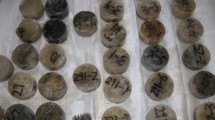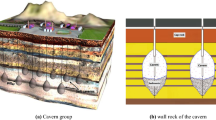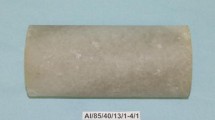Abstract
Rock mechanical behaviors and deformation characteristics are associated with stress history and loading path. Unloading conditions occur during the formation of a salt cavity as a result of washing techniques. Such conditions require an improved understanding of the mechanical and deformation behaviors of rock salt. In our study, rock salt dilatancy behaviors under triaxial unloading confining pressure tests were analyzed and compared with those from conventional uniaxial and triaxial compression tests. The volume deformation of rock salt under unloading was more than under triaxial loading, but less than under uniaxial loading (with the same deviatoric stress). Generally, under the same axial compression, the corresponding dilatancy rate decreased as the confining compression increased, and under the same confining compression, the corresponding dilatancy rate increased as the axial compression increased. The dilatancy boundary of the unloading confining pressure test began with unloading. This is different from the dilatancy of the uniaxial and triaxial compression tests. The accelerated dilatancy point boundary stress value was affected by confining and axial compressions. The specimens entered into a creep state after unloading. The associated creep rate depends on the deviatoric stress and confining compression values at the end of the unloading process. Based on unloading theory and the experimental data, we propose a constitutive model of rock salt damage. Our model reflects the dilatancy progression at constant axial stress and reduced lateral confinement.














Similar content being viewed by others
References
Alkan H (2009) Percolation model for dilatancy-induced permeability of the excavation damaged zone in rock salt. Int J Rock Mech Min Sci 46(4):716–724
Alkana H, Cinarb Y, Pusch G (2007) Rock salt dilatancy boundary from combined acoustic emission and triaxial compression tests. Int J Rock Mech Min Sci 44(1):108–119
Carter NL, Hansen FD (1983) Creep of rock salt. Tectonophysics 92:275–333
Chen ZW, Lv MY, Li LX, Wang Q, Zhang XY, Liu RP (2006) Theoretical investigations on electronic and optical properties of rock-salt gallium nitride. Thin Solid Films 515(4–5):2433–2436
Dolezalova M (2001) Tunnel complex unloaded by a deep excavation. Comput Geotec 28(6–7):469–493
Elaguine D (2006) Hertzian fracture at unloading. Mech Phys Solids 54(11):2453–2473
Guo Y, Yang C, Fu J (2012) Experimental research on mechanical characteristics of salt rock under triaxial unloading test. Rock Soil Mech 33(3):725–730
Guo Y, Yang C, Mao H (2012) Mechanical properties of Jintan mine rock salt under complex stress paths. Int J Rock Mech Min Sci 56:54–61
Hansen FD, Mellegard KD, Senseny PE (1984) Elasticity and strength of ten natural rock salts. In: Proceedings of the first Conference on mechanical behavior of salt (Pennsylvania State University), 71–83
Jiang D, Qiu H, Yi L, Ren S, Chen J (2012) Similar experimental study of cavity building using large-size molded salt rock. Chin J Rock Mech Eng 31(9):1746–1755
Kimberley J, Ramesh KT, Barnouin O (2010) Visualization of the failure of quartz under quasistatic and dynamic compression. J Geophys Res Solid Earth 115:207–215
Li YP, Yang CH, Qian QH, et al (2007) Experimental research on deformation and failure characteristics of laminated salt rock. In: Proceedings of the sixth conference on the mechanical behavior of salt, (Wallner, Lux, Minkley, Hardy), 69–74
Liang W, Xu S, Zhao Y (2006) Experimental study on creep property of rock salt. Chin J Rock Mech Eng 25(7):1386–1390
Ma H (2010) Study of feasibility of rock salt underground gas storage in ultra-deep formation. Dissertation, Wuhan: Institute of Rock and Soil Mechanics Chinese Academy of Sciences
Malmgren L, Saiang D, Toyra J, Bodare A (2007) The excavation disturbed zone (EDZ) at Kiirunavaara mine, Sweden—by seismic measurements. J Appl Geophys 61(1):1–15
Spiers CJ, Carter NL (1996) Microphysics of rock salt flow in nature. In: Proceedings of the fourth conference on the mechanical behaviour of salt, (Aubertin M, Hardy Jr HR) Montreal, Clausthal, 115–28
Tao M, Li X, Wu C (2012) Characteristics of the unloading process of rocks under high initial stress. Comput Geotech 45(6):83–92
Thoms RL, Gehle RM (2000) A brief history of salt cavern. In: 8th world salt symposium, Elsevier, 1–12
Tonge AL, Kimberley J, Ramesh KT (2012) The mechanism of compressive unloading failure in single crystal quartz and other brittle solids. Int J Solids Struct 49(9):3923–3934
Weidinger P, Hampel A, Blum W, Hunsche U (1997) Creep behaviour of natural rock salt and its description with the composite model. Mater Sci Eng A 234–236(30):646–648
Wu G, Zhang L (2004) Studying unloading failure characteristics of a rock mass using the disturbed state concept. Int J Rock Mech Min Sci 41(3):437
Yang CH, Liang WG, Wei DH (2005) Investigation on possibility of energy storage in salt rock in China. Chin J Rock Mech Eng 24(24):4409–4417
Zhou X, Qian Q, Zhang Y (2008) The constitutive relation of crack-weakened dimensional unloading. Acta Mech Solida Sin 21(3):221–231
Zhou HW, Wang CP, Mishnaevsky L et al (2013) A fractional derivative approach to full creep regions in salt rock. Mech Time Depen Mater 17(3):413–425
Acknowledgments
This research was supported by the Natural Science Fund for creative research groups in China (Nos. 51304256; 51204216), China Postdoctoral Science Foundation (No. 2013M540620), the Fundamental Research Fund of the central universities of China (No. CDJZR13240022), and the National Key Technology R&D Program (No. 2012BAK04B09), which are all greatly appreciated.
Author information
Authors and Affiliations
Corresponding author
Rights and permissions
About this article
Cite this article
Chen, J., Jiang, D., Ren, S. et al. Comparison of the characteristics of rock salt exposed to loading and unloading of confining pressures. Acta Geotech. 11, 221–230 (2016). https://doi.org/10.1007/s11440-015-0369-9
Received:
Accepted:
Published:
Issue Date:
DOI: https://doi.org/10.1007/s11440-015-0369-9




